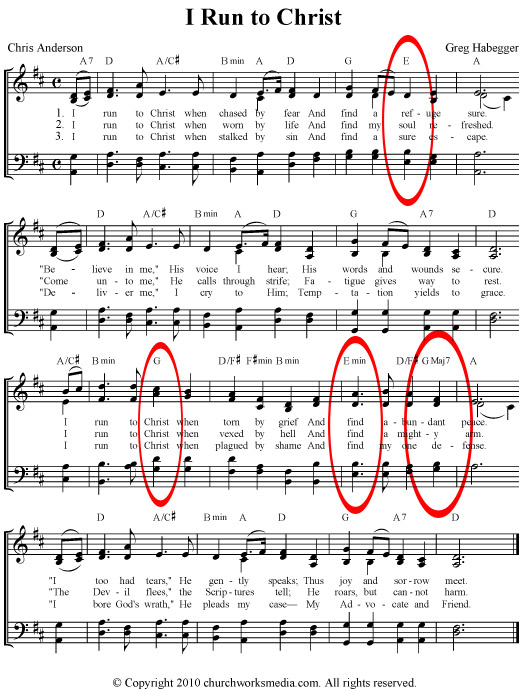Free Lessons
An example of great harmony: “I Run To Christ”
On my next recording, I am including several newer songs, some of which are written by friends of mine. Two of them, Christ Anderson and Greg Habegger, collaborated on “I Run To Christ.” From a musical standpoint, there is a lot to like about this hymn. The most obvious thing is its natural shape, or the way it swells in the B section (3rd line). It is very easy to write a good arrangement from this.
Another strength is the harmony. Many of you know that I am a frequent critic of the harmony that exists in the songs in a typical hymnal. Most hymns use harmony that is outdated and simplistic. Much contemporary music utilizes far better harmony, and that includes this particular hymn.
When we reharmonize, we are not just trying to come up with cool chords. We are also focused on how chords interact with the melody notes. In general, the further the melody notes are moved away from the base of a chord (the 1st, 3rd, and 5th), the prettier the sound. For example, if the melody note is the 7th of a chord, it will sound better than if it is the 5th of a chord. If you can move the melody note to the 9th, 11th or 13th, that is a better sound still.
In a typical gospel song, you will note that almost all the time, melody notes are either the 1st, 3rd, or 5th of the chord. In fact, most writers are taught to pick chords based on if a melody note matches one of the notes of the triad. For example, if you are in the key of C and the melody note is C, writers tend to use either a C or F triad there because they both include a C.
With that being said, watch how the writer took advantage of melody notes away from the common triad tones. I have circled the places of interest. By the way, you can download this hymn for free (and others) at ChurchWorksMedia. They are all provided for personal or church use with very liberal licenses.

Note the melody note is used as a 7th on the first line on the Emin7. In the third line, it gets more interesting. A C# in the melody is the #11 of a GMaj7 chord. I realize there is no major 7th in the chord (there easily could be), but it still works well. Then you have an A (11th) against an Emin7 and a F# (Maj7th) against a GMaj7.
These are the kinds of things that make music good. I could talk about more as well such as the use of the Asus chords. Habegger wrote this very well.
By the way, if you want to learn more about this relationship between melody notes and chords, here is a video that I put out last year on this topic.
